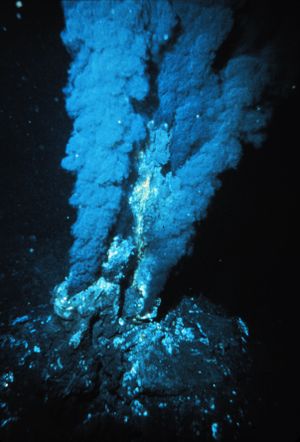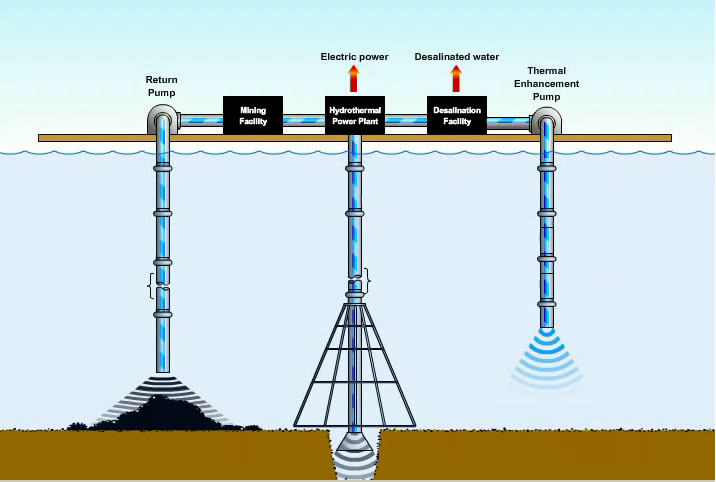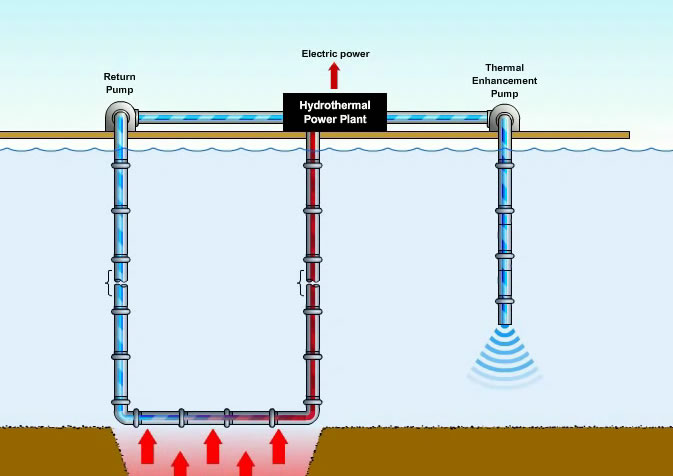Hydrothermal
The Marshall System is a proposal to utilize underwater hydrothermal vents for energy and/or mineral resources. In one proposed version of the system, the vent would be capped off and the hydrothermal fluid directed to the sea surface using buoyant, insulated pipes. A floating platform or ship on the surface would then extract the heat out of the hydrothermal fluid and then use it for power generation.
In the other, closed loop system, a loop of pipe would go from a floating platform or ship on the surface, down to the ocean floor, next to or in the hydrothermal vent, and would return to the ship or platform. A heat exchanger outside of the pipe but within the vent would heat working fluid which would then be directed to the surface and used for power generation. The used working fluid would then be returned to the sea floor and be reheated.
Hydrothermal Vents

Hydrothermal vents typically spew out superheated fluid as high as 407 degrees Celsius at velocities ranging from 1-5 m/s. The vent openings are anywhere from a couple inches to several meters. The 1-5 m/s flow happens at depths of typically 2,300 m below sea level which is a pressure of about 200 atmospheres. The vent's pressure is provided by the weight of seawater forcing itself into fissures within the Earth's crust which gets superheated and forced out of these vents.
Recoverable Energy
Assuming a 3m opening and 3 m/s flow at 350 degrees Celsius, this is a flow of 21,205.73 L/sec which translates into 29,298.77 MW of power. The typical fission nuclear reactor provides 4,000 MW of power.
Technical challenges
The depth of the hydrothermal vents at Juan de Fuca plate is about 1500m, well within reach of conventional oil rigs. But other technical challenges remain.
For the open system: if a vent was successfully capped, would the hydrothermal fluid continue flowing? Would the heat rise so that it can be used at sea level?
For the closed system: how much heat could be captured from the vent using a heat exchanger?
Economic challenges
How much would either system cost? Would either be competitive with traditional methods of power generation such as nuclear?
A nuclear power plant costs 2000 per kW so a 4GW plant would cost about $8 billion.
A semi-submersible oil platform for deep ocean use costs $500 million to $1 billion. Drilling the vent would cost 100 million (probably less because one would not need to drill deep into the earth).
An undersea cable from Juan de Fuca would have to be 200 miles which is around the same length of the longest underwater cable. Unfortunately, transmission capacity for that cable is only 700 MW and it cost 550 million euros which is about 800 million dollars. So to reach 4 GW 6 of these cables would be needed which is $4.8 billion. Total so far, about $5.8 billion and the generators haven't been accounted for.
From these estimates, this proposal is definately viable but there are many technological hurdles that need to be considered.

